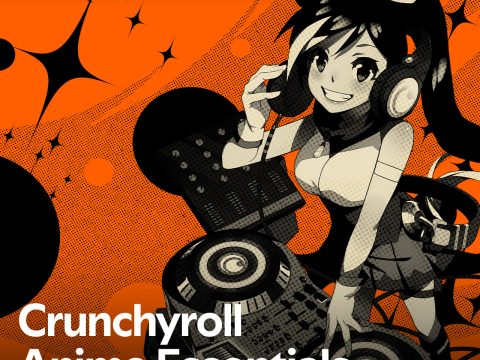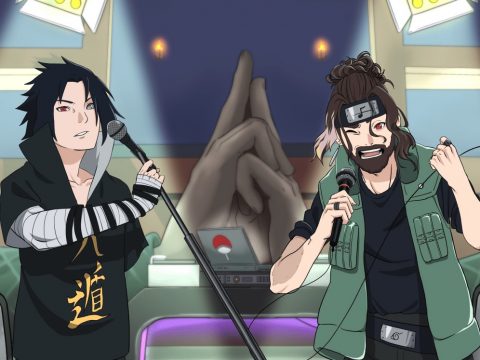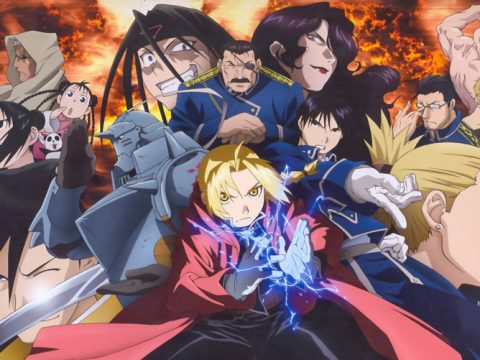
Originally formed in 1975 by Blues Interactions as a label re-issuing blues and R&B acts, P-Vine Records specializes in the art of the rerelease.
In 1999 they put together an amazing collection of early 80s synth pop and electro new-wave called Techno Ca-Yo. The collection spans 128 tracks spread out over eight discs and roughly 10 years, from 1979 to 1987. Even more interesting is that each disc is a collection from a single label.
As a whole, the collection is imposing to say the least. The quality ranges from super-slick to rather rough, which can make for some rocky, if not downright tedious, listening. Each collection holds a few gems for the intrepid listener, and any fan of zany electro pop will find a lot to love.
 Digita Love (Toshiba EMI)
Digita Love (Toshiba EMI)
Things get started early with, surprisingly, a cover of Hikasu’s “Pike•bCrLf by American surf-rock pioneers The Ventures. Not surprisingly, they take the ominous and robotic original and turn it into an up-tempo beach-rock swinger. This version would also be co-opted by Polysics, who put the lyrics back in on their 1999 A.D.S.R.M. album. Speaking of Polysics, their more recent cover of “Computer Obaachan,•bCrLf released on the Rock for Baby compilation, appears here in its original form. The song was produced by Yellow Magic Orchestra founder Ryuichi Sakamoto and features child singer Yuko Sakaitsukasa singing the Sesame Street-esque lyrics. This child-like feel is another staple of the Techno Ca-Yo collections, which are heavy on the happy and silly side. Ritsuko Ohwada’s “Uchu-jin no Telepathy•bCrLf is cruelly catchy with its “te te te te tele-pashii•bCrLf verses, and Kenji Haga’s cover of “Neverending Story•bCrLf is an absolutely hilarious essential. The disc ends with a very simple, yet elegant and dreamy single from the aforementioned Sakamoto (you’ll see YMO’s DNA splashed all over these collections) which features, predictably, some beautiful synth sounds.
 Heartbreak Taiyo-Zoku (Polydor)
Heartbreak Taiyo-Zoku (Polydor)
ES Island’s “Tech Tech Mummy•bCrLf is the immediate stand-out here, with its “Techu mummy no bestu friendo!•bCrLf chant and ska-fueled beats. Sakamoto makes another appearance, this time along with Kiyoshiro Imawano on “I-ke-na-i Rouge Magic.•bCrLf Here he tries to tackle something along the lines of “Let’s Dance•bCrLf-era David Bowie, with disastrous results. All is quickly forgotten when Masato Shimon’s cover of the Star Wars theme kicks in. Much like other disco mixes, this one bumps and twirls along, with a heavy dose of camp added due to Shimon’s over-the-top vocal performance. That’s right, he adds some crazy vocals over not only the main theme, but the Cantina tune as well! Yukano Yamaguchi sings the super catchy “Chinese Boy,•bCrLf which Aneka would later cover in a deliciously racist way as “Japanese Boy.•bCrLf Ikkaku Tanabe cranks up the constipated Max Headroom factor with vocal cut-up and samples on “Kyikyuku no Sentaku,•bCrLf and Lum fans will recognize “Hoshizora Cycling•bCrLf from Virgin VS. Lun-a lun-a lun-away  home.
home.
Cosmic Surfin’ (Victor)
Covered recently by the ill-fated Hello! Project duo W, “Senti Metal Boy•bCrLf by Kirara & Urara is an appropriately catchy and poppy start to this disc. The title track comes from YMO cover band Cosmic Invention. They take on the more straightforward 1981 live version of “Cosmic Surfin’,•bCrLf adding vocals and a much stronger disco feel. (Side note, Cosmic Invention also did a great cover of “Computer Obaachan.•bCrLf) They have a second song, “Yakimoki•bCrLf on this one as well, though it’s not quite as catchy.
 SOS Pen Pen Computer (Pony Canyon)
SOS Pen Pen Computer (Pony Canyon)
Once again, fans of Urusei Yatsura will immediately recognize the lead track, Yuko Matsuya’s “Ram no Love Song,•bCrLf as the theme from the anime, retitled “Lum no Love Song.•bCrLf YMO’s Haruomi Hosono pops up a lot on this collection, producing several of the tracks. Overall it’s one of the least memorable of the eight discs, featuring a lot of dry and less wacky material. Then again, the title track “SOS Pen Pen Computer•bCrLf is pretty out there, with lots of call and response breaks and some really weird backing vocals.
Lovely Singing Circuit (Teichiku)
Hosono makes another appearance here as F.O.E. in the wildly out of place version of James Brown’s “Sex Machine.•bCrLf It combines the vocals from the godfather of soul with a heavily robotic bass-line and drum machine, along with a host of other annoying shouts and samples. Very weird. Yapoos makes two appearances, with the operatic “Cecil Cut•bCrLf and the wild art-rock “Barbara Sexanoid.•bCrLf By far the stand-out track here is The Targets’ cover of the “Theme from E.T.•bCrLf Taking the main melody, adding lyrics, and totally obliterating them through some heavy vocoder action is a stroke of pure genius. It manages to totally capture the magic of dreamy early 80s synths.
Techno Aquarium (Alfa)
 Yellow Magic Orchestra makes a rather disappointing appearance for the first and only time with the opening track to this disc. Sure, “Kimi Ni Mune Kyun•bCrLf is kitschy and silly, but it’s still a bit bland. “Capricious Salad•bCrLf by Miharu Koshi is a direct progenitor to Budo Grape and other modern new-wave acts that like it light and poppy. It keeps things basic with a single keyboard and drum line, instead relying on the super-cute vocals to carry it through. “Souvenir Glace•bCrLf from Testpattern is a dreamy tribute to Kraftwerk with floating French lyrics. Of course Hajime Tachibana of The Plastics goes right out and samples Kraftwerk on “Rock,•bCrLf adding, once again, some oh-so-sweet vocoded vocals.
Yellow Magic Orchestra makes a rather disappointing appearance for the first and only time with the opening track to this disc. Sure, “Kimi Ni Mune Kyun•bCrLf is kitschy and silly, but it’s still a bit bland. “Capricious Salad•bCrLf by Miharu Koshi is a direct progenitor to Budo Grape and other modern new-wave acts that like it light and poppy. It keeps things basic with a single keyboard and drum line, instead relying on the super-cute vocals to carry it through. “Souvenir Glace•bCrLf from Testpattern is a dreamy tribute to Kraftwerk with floating French lyrics. Of course Hajime Tachibana of The Plastics goes right out and samples Kraftwerk on “Rock,•bCrLf adding, once again, some oh-so-sweet vocoded vocals.
 Aitsu wa Invader (Tokuma Japan)
Aitsu wa Invader (Tokuma Japan)
This one doesn’t waste any time getting right to the best song with the title track from Maki Ueda. Much like the other disco versions of other popular 80s culture, this one take on the theme of the Space Invaders video game. It’s chock full of samples taken straight from the game, most notably the laser sounds and the warbling of the “you-foe.•bCrLf G-G-Land brings back the child chorus with “Himitsu Wa Chack,•bCrLf full of overperforming kids, the thousand-words-per-minute-chorus, and some nice 8-bit solos. Artist Children seems to sing about eating various parts of his body with his girlfriend. Along with singing in a super falsetto voice like that of that guy from The Darkness, the music is equally strange, with the marimbas giving it a sunny day on the beach feel. This is then contrasted with the heartbreakingly beautiful theme to Nausicaä of the Valley of the Wind, “Kaze No Tani No Nausicaa•bCrLf sung by Narumi Yasuda. Ueda ends the disc with yet another Space Invaders cash-in “Invader Walk.•bCrLf Not nearly as good as the first.
Electric Love Story (King)
 Speaking of cashing in, this collection features a fairly straightforward cover of the Super Mario theme by Bonus 21. It adds nothing, but somehow manages to take most of the life out of the original. No small task. “Let’s Find Our Bright Speed Again•bCrLf by Earthling sounds like a marriage between The Plastics’ tight guitars and spastic vocals and Gary Numan’s low-fi synths.
Speaking of cashing in, this collection features a fairly straightforward cover of the Super Mario theme by Bonus 21. It adds nothing, but somehow manages to take most of the life out of the original. No small task. “Let’s Find Our Bright Speed Again•bCrLf by Earthling sounds like a marriage between The Plastics’ tight guitars and spastic vocals and Gary Numan’s low-fi synths.
Much of this collection is pretty shaky though, definitely a low point for the series. The ending track “Uchu Yori No Pantsman,•bCrLf with its swing beat and chorus of kids screaming “Pantumaaan!•bCrLf is definitely a winner, though, and almost saves it.
Obviously there is no end to where the various loose threads here and a familiarity with Google could lead you. There’s a huge amount of history to be found, not only among what’s included, but also everything that surrounds the various people involved. While the track lists are hit-or-miss, to say the least, the hits will all lead the curious listener on a path turning ever deeper into the Japanese music-scape, both past and present. It’s very easy to get lost, but that’s only a problem if you care to get back home.
[Excerpted from the June 2008 issue of Otaku USA magazine.]







